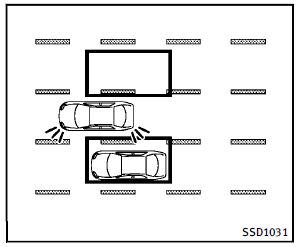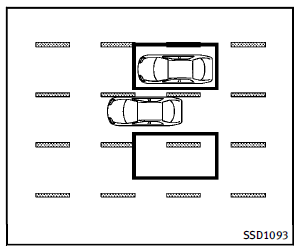BSW/Blind Spot InterventionTM driving situations


Another vehicle approaching from behind
The BSW/Blind Spot InterventionTM indicator light illuminates if a vehicle enters the detection zone from behind in an adjacent lane. However, if the overtaking vehicle is traveling much faster than your vehicle, the indicator light may not illuminate before the detected vehicle is beside your vehicle. Always use the side and rear mirrors and turn and look in the direction your vehicle will move to ensure it is safe to change lanes. Starting

If the driver activates the turn signal, then the BSW/Blind Spot InterventionTM indicator light flashes and a chime will sound twice.
NOTE:
If the driver activates the turn signal before a vehicle enters the detection zone, the BSW/Blind Spot InterventionTM indicator light will flash but no chime will sound when the other vehicle is detected.

If the Blind Spot InterventionTM system is on and your vehicle is approaching a lane marker, the BSW/Blind Spot InterventionTM indicator light flashes and a chime will sound three times. Then the Blind Spot InterventionTM system slightly applies the brakes on one side to help return the vehicle back to the center of the driving lane.

NOTE:
If you accelerate from a stop with a vehicle in the detection zone, the other vehicle may not be detected.
Overtaking other vehicles

The BSW/Blind Spot InterventionTM indicator light illuminates if you overtake a vehicle and that vehicle stays in the detection zone for approximately 3 seconds. The radar sensors may not detect slower moving vehicles if they are passed quickly.

If the driver activates the turn signal while another vehicle is in the detection zone, then the BSW/Blind Spot InterventionTM indicator light flashes and a chime will sound twice.

If the Blind Spot InterventionTM system is on and your vehicle approaches a lane marker while another vehicle is in the detection zone, the BSW/Blind Spot InterventionTM indicator light flashes and a chime will sound three times. Then, the Blind Spot InterventionTM system slightly applies the brakes on one side to help return the vehicle back to the center of the driving lane.
NOTE:
When overtaking several vehicles in a row, the vehicles after the first vehicle may not be detected if they are traveling close together.
Entering from the side


The BSW/Blind Spot InterventionTM indicator light illuminates if a vehicle enters the detection zone from either side.
NOTE:
The radar sensors may not detect a vehicle which is traveling at about the same speed as your vehicle when it enters the detection zone.

If the driver activates the turn signal, then the BSW/Blind Spot InterventionTM indicator light flashes and a chime will sound twice.
NOTE:
If the driver activates the turn signal before a vehicle enters the detection zone, the BSW/Blind Spot InterventionTM indicator light will flash but no chime will sound when another vehicle is detected.

If the Blind Spot InterventionTM system is on and your vehicle approaches the lane marker while another vehicle is in the detection zone, the BSW/Blind Spot InterventionTM indicator light flashes and a chime will sound three times. Then, the Blind Spot InterventionTM system slightly applies the brakes on one side to help return the vehicle back to the center of the driving lane.

NOTE:
► The Blind Spot InterventionTM system
will not operate if your vehicle is on a
lane marker when another vehicle
enters the detection zone. In this case
only the BSW system operates.
► Blind Spot InterventionTM braking will
not operate or will stop operating and
only a warning chime will sound under
the following conditions.
— When the brake pedal is depressed.
— When the accelerator pedal is depressed
while brake control assist
is provided.
— When steering quickly
— When the ICC, DCA, FCW or IBA
warnings sound.
— When the hazard warning flashers
are operated.
— When driving on a curve at a high
speed.
BSW/Blind Spot InterventionTM temporarily not available
► Under the following conditions, the
Blind Spot InterventionTM system will
be turned off automatically, a beep will
sound and the Blind Spot InterventionTM
ON indicator light (green) will
blink. The BSW system is still available,
but the Blind Spot InterventionTM system
will not be available until the
conditions no longer exist.
— When the VDC system (except TCS
function) or ABS operates.
— When the VDC system is turned off.
— When the drive mode select switch
is turned to the SNOW mode.
Action to take:
Turn off the Blind Spot InterventionTM
system and turn it on again when the
above conditions no longer exist.
► Under the following conditions, the
BSW and Blind Spot InterventionTM
systems will be turned off automatically,
a beep will sound and the BSW/
Blind Spot InterventionTM system warning
light (orange) will blink. The BSW
and Blind Spot InterventionTM systems
are not available until the conditions no
longer exist.
— When the camera detects that the
interior temperature is high (over
approximately 1048F (408C)).
— When radar blockage is detected.
The radar sensors may be blocked by
temporary ambient conditions such as
splashing water, mist or fog. The blocked
condition may also be caused by objects
such as ice, frost or dirt obstructing the
radar sensors.
Action to take:
When the above conditions no longer exist,
the BSW system will resume automatically.
For the Blind Spot InterventionTM system,
turn it off and turn it on again. If the BSW/
Blind Spot InterventionTM warning light
(orange) continues to blink even after the
Blind Spot InterventionTM system is turned
on again, stop the vehicle in a safe location
and turn the engine off. Check for and
remove objects obscuring the radar sensors
on the rear bumper, and restart the
engine.
If the warning light (orange) continues to
blink, have the BSW/Blind Spot InterventionTM
systems checked by an INFINITI
retailer.
See also:
Capacities and recommended fuel/lubricants
The following are approximate capacities. The actual refill capacities may
be slightly different. When refilling, follow the procedure described in the
“Maintenance and do-it-yourself” section to ...
Bluetooth Hands-Free Phone System withoutNavigation System (if so equipped)
WARNING
● Use a phone after stopping your vehicle in a safe location. If you have to use a phone while driving, exercise extreme caution at all times so full attention may be given to vehicle ...
Extending engine run time
time by performing the steps listed in “Remote starting the vehicle” in this section. Run time will be calculated as follows:
● The first 10 minute run time will start when the remote start f ...
